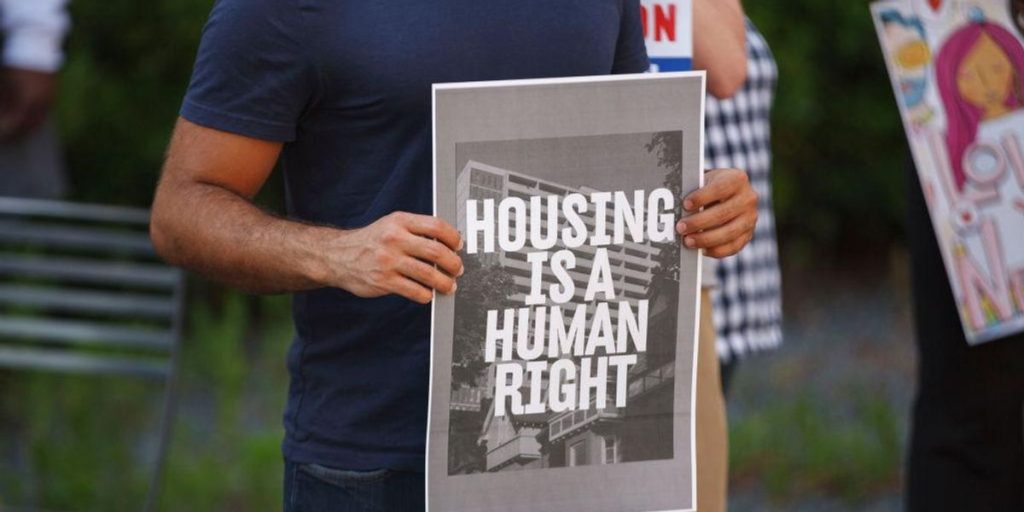
Economic justice advocates on Thursday said that to determine the strength of the Biden administration’s new nonbinding push for renter protections from the federal and state governments and private sector, one needs to look only at the elated response from corporate landlords.
The Revolving Door Project (RDP) pointed to comments from the National Apartment Association (NAA) and the National Multifamily Housing Council (NMHC), lobbying groups that represents landlords, that followed the White House’s unveiling on Wednesday of its “Resident-Centered Housing Challenge” and “Blueprint for a Renters Bill of Rights.”
“What we can say with certainty is NAA’s advocacy helped avert an executive order advanced by renters advocates and members of Congress, which would have imposed immediate policy changes,” said the NAA in a statement on Thursday.
“The NMHC—which does the bidding of the nation’s leading corporate landlords—celebrated the omission of national rent control from the White House plan while also objecting to other ‘onerous regulations’ contained in the release, which it claimed would ‘discourage much-needed investments in housing supply,'” said Andrea Beaty, research director for the RDP.
“The Biden administration has apparently decided to assume that corporate landlords are good-faith actors with their tenants’ best interests at heart, despite all of the evidence to the contrary, and just plain common sense,” added Beaty. “The best the Biden administration offered is industry-approved, nonbinding measures that kick the can down the road.”
The lobbying groups’ response came as housing justice advocates noted that they have spent roughly a year calling on President Joe Biden to do everything in its power to address housing insecurity and the crisis facing households that are rent-burdened.
As Moody’s Analytics reported on Thursday, the average U.S. tenant is now rent-burdened, which is defined as paying 30% or more of a household’s income on rent.
“Tenant stories and expertise informed these actions, and tenants will continue to be central to policymaking that concerns their lives.”
The firm compared the national median household income—$71,721—with 2022’s average rent of $1,794. In 2021 the average renter paid 28.5% of their income on rent, and in 2020 they paid 25.7%.
The latest statistics represent “a symbolic threshold, a milestone,” Thomas LaSalvia, director of economic research at Moody’s, toldThe New York Times.
“The rent-to-income ratio continued to climb up because income growth was not able to catch up with the rent growth,” Lu Chen, a senior economist at the firm, told the newspaper.
Following months of meetings between tenant groups and administration officials, as well as advocacy by Sen. Elizabeth Warren (D-Mass.) on behalf of renters, the White House on Wednesday proposed a number of actions the government will take to gather data about the housing crisis and push federal agencies—but not require them—to consider how they can curb rent costs.
The White House said it had secured commitments from the Federal Trade Commission and the Consumer Financial Protection Bureau to “collect information to identify practices that unfairly prevent applicants and tenants from accessing or staying in housing.”
The Federal Housing Finance Agency (FHFA) said it would “launch a new public process to examine proposed actions promoting renter protections and limits on egregious rent increases for future investments,” while a workshop by the U.S. Department of Justice will address “anti-competitive information sharing, including in rental markets.”
The Biden administration also said the U.S. Department of Housing and Urban Development will propose new rules requiring public housing and rental assistance authorities to provide 30 days’ notice before terminating a lease due to rent nonpayment.
The White House also released a nonbinding Blueprint for a Renters Bill of Rights, affirming tenants have the right to clear and fair leases, to organize, and to have access to safe, quality, and affordable housing. Its Resident-Centered Housing Challenge, starting in the spring, will encourage state and local governments to enhance policies that promote fairness in the rental market, urging them to “make their own independent commitments that improve the quality of life for renters.”
People’s Action, whose Homes Guarantee campaign helped lead efforts to secure renter protections and rent price regulations, said its organizers helped “shape this policy for the better,” and said the commitment from the FHFA offers an opportunity for the agency “to create a policy that helps check the power of landlords.”
But as the NAA boasted, People’s Action told The Washington Post that the policies will not change “tenants’ lives materially today.”
“Tenant stories and expertise informed these actions, and tenants will continue to be central to policymaking that concerns their lives,” said Tara Raghuveer, director of the Homes Guarantee campaign. “The rent is still too damn high. While the White House announcement affirms a role for the federal government in correcting the imbalance of power between landlords and tenants, the president can do much more to provide relief to tenants. We are counting on this administration to continue working with our campaign to make it happen.”
Ahead of Biden’s proposal, People’s Action led 281 national and local tenant organizations in calling on the White House to direct federal agencies to:
- Protect tenants from unfair, unjust, and unaffordable rent hikes, fines, and fees through rent regulation;
- Expand and enforce tenant protections by defining “good cause” eviction; and
- Address the consolidation of the rental market by corporate landlords.
“Rent is a significant economic issue the Biden administration has the opportunity to tackle. They should take it,” Raghuveer said. “These actions are the essential components of any meaningful strategy to protect tenants, and they complement other White House priorities to strengthen and grow the American economy, like their work to limit market consolidation and monopoly price-setting power.”

